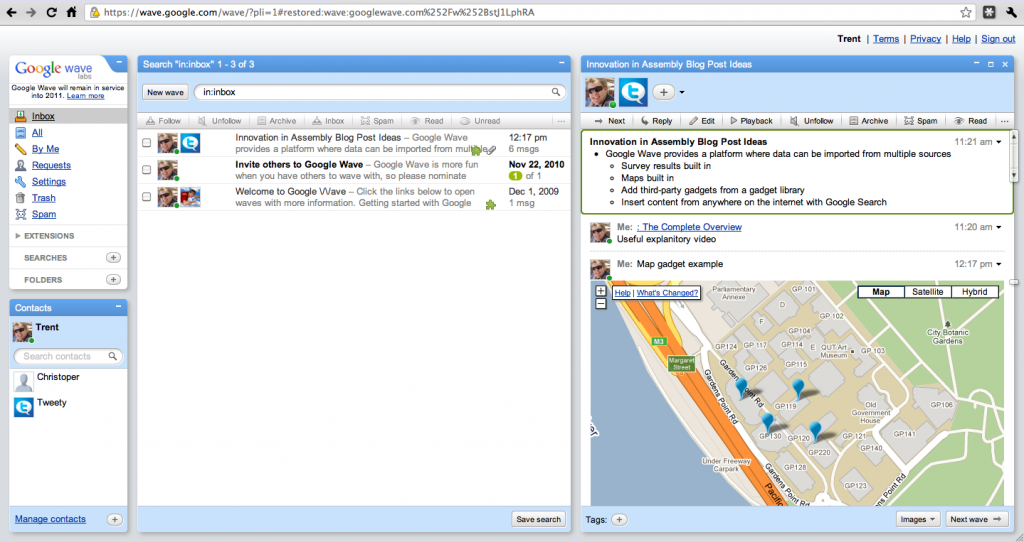Innovation in Assembly is a design pattern positioned within Tim O’Reilly’s vision of Web 2.0. The pattern deals with the explosion of data available online due to shifts in technology and related use cases. The ability to leverage this data has become a key strategic advantage. There are a lot of companies leveraging their systems and data to deliver more customer value, including Flickr’s App Garden.
Google is well known as an innovative company which continuously strives to make use of new data sources and the information it makes available through it’s own knowledge of the Internet (i.e. through it’s massive search index and property portfolio). There were a lot of Innovation in Assembly examples that could be covered here: Google Public Data Explorer (a great way to view worldwide statistical data; I was tempted to blog about it) is just one example. Regardless, I found a much more useful tool (on a personal level) from Google: Google Wave.

Google Wave is a tool that facilitates communication, data aggregation and content creation in one central location. The tool provides a collaborative environment where users work together in real time on a “document”. A document can be anything, and Google allows users to add Maps, video, images and so much more data from Google’s own sources, plus from search results. Developers and organisations can build their own gadgets to provide user’s access to their data using Google’s open APIs for Wave extensions (called Gadgets and Bots).
The Wave tool is currently not under active Google development, but there is an active community of people using the tool and developing Wave gadgets and bots. Because Google makes the product open source, provides API options (for bots and extensions) and provides clear community guidelines means people are willing to contribute to the product. So much data becomes accessible in a flexible, collaborative environment. The openness of the platform and the flexibility provided enables collation and connection of data from any web-connected resource (As per O’Reilly’s statements in his famed 2005 article on Web 2.0. Google emphasises community and platform involvement, making functionality highly available and involving people in the process (see the Community Principles) of development. This entire integration of data, sources, users and Google means the Google, although not building the product, has created a product which is the epitome of Innovation in Assembly.
The power of Google Wave lies in the power of Google’s Search capabilities, the ability to link to a Wave (making data available – part of the “Data is the Next Intel Inside” design pattern) and the ingenuity and contribution of community developers. The openness of Google Wave means it can be reused and modified under Open Sources licenses, enabling remixing (another part of the Innovation in Assembly design pattern). Core Wave functionality is empowered by Google using it’s own API hooks to their services (such as search and Maps) and allowing users to create Gadgets and Bots which introduce new data and functionality.
Google Wave changes the way I collected and recorded blog content. What will it do for you?
Its interesting that Google is no longer developing Google Wave, but a whole community of developers are. Have you heard of any successful add on’s or Bots that have been released? It sounds like Wave utilises several of O’reilly’s patters and combines them to create an innovative product. Do you think products need to adhere to several patterns to be succesful? or only deliver one – and deliver it well?
Hi Steph,
There were quite a few in the day. I tried out a Twitter one, but I couldn’t get it to work unfortunately. They had bots that automatically cleaned up posts that were empty or had blank spaces as a really basic one. Extensions are more complex than bots (which really only do one very simple task). There is an entire showcase here: http://wave.google.com/extensions.html. Examples include planning trips together, making use of Amazon data, my personal favourite, performing Business Process Modelling using BPMN!
Google Wave is a great example of this core pattern. I’m glad to see that it’s still being used, even if it’s no longer being developed by Google directly.
I think one of the main problems that perhaps contributed to Wave’s lack of popularity was that it was hard for the average user to define exactly what it did. You couldn’t just describe it as a communication tool, because there is so much more to it than that.
I think that may be true. This may be an example of Innovation in Assembly gone too far. By making things so open, there was too much data, confusing end users too much. For IT people, I guess lots of datais exciting, but not so much for all other target markets. What do you think about that statement?
I wondered when someone would talk about Google Wave, it certainlly is a good example of innovation as most of Googles Products are, i was unaware that a group of developers are still developing it, last i heard it was dead and no one was interested, i’m glad that is no longer the case, as it is a rather interesting use of data, i also agree with Dan that one key reason for it’s lack of popularity was that it was hard to determine what it actually did, i think if Google marketed it properly, it would have taken off quite well.
Hi Ben,
Google Wave seems to have a ver dedicated, niche market with Wave. The people who have discovered uses for it are clinging on to it and still supporting bots, extensions and the Wave project. I agree with you point that there was too much innovation here and its actually difficult to figure out a use case for the technology that works in practice. How would you use Google Wave in your life, knowing a little bit about the technology?